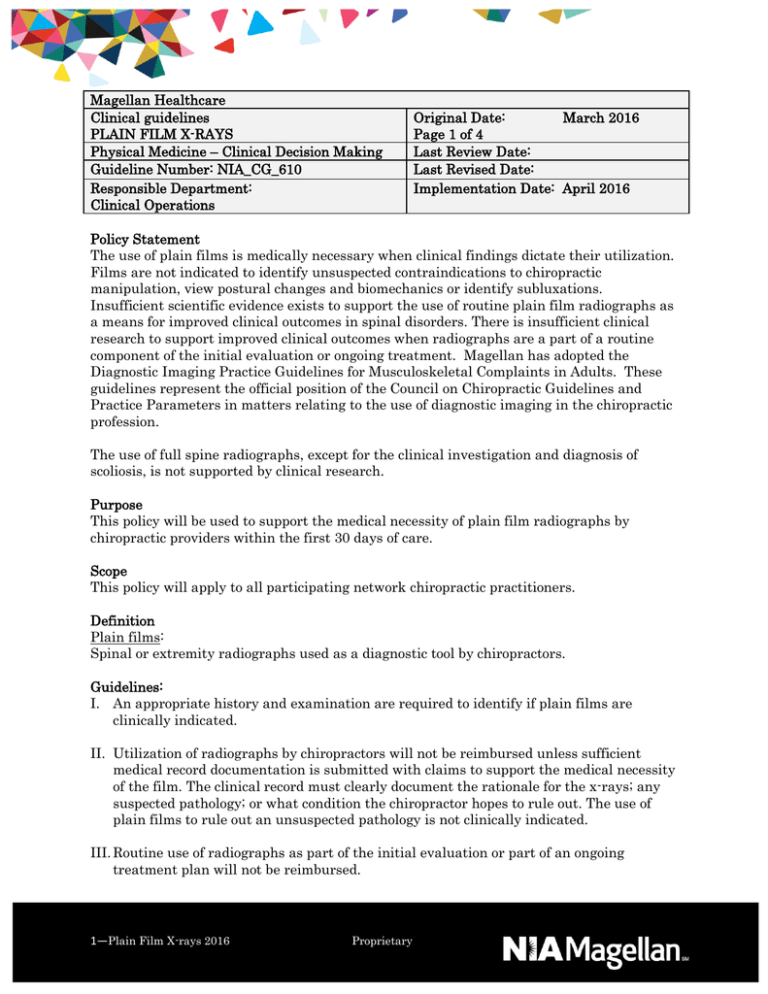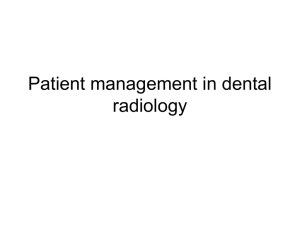Magellan Healthcare Clinical guidelines PLAIN FILM
advertisement

Magellan Healthcare Clinical guidelines PLAIN FILM X-RAYS Physical Medicine – Clinical Decision Making Guideline Number: NIA_CG_610 Responsible Department: Clinical Operations Original Date: March 2016 Page 1 of 4 Last Review Date: Last Revised Date: Implementation Date: April 2016 Policy Statement The use of plain films is medically necessary when clinical findings dictate their utilization. Films are not indicated to identify unsuspected contraindications to chiropractic manipulation, view postural changes and biomechanics or identify subluxations. Insufficient scientific evidence exists to support the use of routine plain film radiographs as a means for improved clinical outcomes in spinal disorders. There is insufficient clinical research to support improved clinical outcomes when radiographs are a part of a routine component of the initial evaluation or ongoing treatment. Magellan has adopted the Diagnostic Imaging Practice Guidelines for Musculoskeletal Complaints in Adults. These guidelines represent the official position of the Council on Chiropractic Guidelines and Practice Parameters in matters relating to the use of diagnostic imaging in the chiropractic profession. The use of full spine radiographs, except for the clinical investigation and diagnosis of scoliosis, is not supported by clinical research. Purpose This policy will be used to support the medical necessity of plain film radiographs by chiropractic providers within the first 30 days of care. Scope This policy will apply to all participating network chiropractic practitioners. Definition Plain films: Spinal or extremity radiographs used as a diagnostic tool by chiropractors. Guidelines: I. An appropriate history and examination are required to identify if plain films are clinically indicated. II. Utilization of radiographs by chiropractors will not be reimbursed unless sufficient medical record documentation is submitted with claims to support the medical necessity of the film. The clinical record must clearly document the rationale for the x-rays; any suspected pathology; or what condition the chiropractor hopes to rule out. The use of plain films to rule out an unsuspected pathology is not clinically indicated. III. Routine use of radiographs as part of the initial evaluation or part of an ongoing treatment plan will not be reimbursed. 1—Plain Film X-rays 2016 Proprietary IV. The use of full spine radiographs for any diagnosis other than scoliosis is not considered medically necessary and will not be reimbursed. V. Contraindications to plain film x-rays includes: a. Infants (0-36 months) b. Pregnancy or possible pregnancy c. Obesity, if size precludes good radiographic resolution d. Patient has positioning difficulty due to mental status or physical restrictions, which precludes good radiographic resolution e. Children 3 to 18 years of age, except for investigation of suspected acute fracture, dislocation, infection, scoliosis, developmental defects, or a suspected pathology. CLINICAL EXAMPLES of Medically Necessary X-Rays (from references 14-16): Investigation of suspected acute fracture Follow up radiographs to monitor a healing fracture Investigation of suspected bony dislocation Evaluation of prior surgical site where manual based treatment may be applied (where no previous films are available for review) Suspect (patient history, pain characteristics and/or physical examination) malignancy, infection, systemic disease, or inflammatory spondyloarthropathology Precise quantification of clinically suspected active child or juvenile scoliosis Persistent (same or worse pain) after first month of treatment Significant history of drug or alcohol abuse such as IV drugs or chronic alcoholism or chronic use of steroids CLINICAL EXAMPLES OF X-RAY VIEWS RECOMMENDED IN THE LITERATURE (from reference 16): Adult with recent unimaged thoracolumbar, lumbar or thoracic blunt trauma – AP (or PA) and lateral thoracic and/or lumbar views Suspected lumbar degenerative spinal stenosis or spondylolisthesis if patient is greater than 50 years of age and/or has progressive neurological deficit – AP (or PA) and lateral lumbar views Adult with recent unimaged blunt trauma to pelvis and unable to bear weight – AP pelvis and lateral hip “frog leg” views Acute neck pain with recent unimaged dangerous trauma, paresthesia in extremities or age greater than 65 or non-traumatic neck pain with radicular symptoms – APOM, AP lower cervical and lateral neutral views Adult with painful or progressive scoliosis – Erect sectional standing full spine (14x36) PA and lateral views in the absence of recent films 2— Plain Film X-rays 2016 Proprietary REFERENCES 1. Ammendolia C, Hogg-Johnson S, Pennick V, et al. Implementing evidence-based guidelines for radiography in acute low back pain: a pilot study in a chiropractic community. J Manipulative Physiol Ther. 2004;27(3):170-9. 2. Bigos S, Bowyer O, Brean G, et al. Acute low back problems in adults. Clinical practice guideline no. 14. Washington DC: US Government Printing Office; AHCPR Publication no. 95-0642. 1994. 3. Borenstein DG. A clinician’s approach to acute low back pain. Am J Med. 1997;102:16S-22S. 4. Jarvik JG. Imaging of adults with low back pain in the primary care setting. Neuroimaging Clin N Am. 2003;13(2):293-305. 5. Kendrick D, Fielding K, Bentley E, et al. Radiography of the lumbar spine in primary care patients with low back pain: randomized controlled trial. BMJ. 2001;322:400-405. 6. Kendrick D, Fielding K, Bentley E, et al. The role of radiography in primary care patients with low back pain of at least 6 weeks duration: a randomized controlled trial. Health Technol Assess. 2001;5(30):1-69. 7. Magora A, Schwartz A. Relation between low back pain syndrome and X-ray findings. Degenerative osteoarthritis. Scand J Rehabil Med. 1976;8:115–25. 8. Mootz R, Hoffman L, Hansen D. Optimizing clinical use of radiology and minimizing radiation exposure in chiropractic practice. Topics in Clinical Chiropractic. 1997;4:34-44. 9. New Zealand Acute Low Back Pain Guide (June 2003 Edition) www.nzgg.org.nz 10. van den Hoogen HMM, Koes BW, van Eijk JT, et al. On the accuracy of history, physical examination, and erythrocyte sedimentation rate in diagnosing low pain in general practice. A criteria-based review of the literature. Spine. 1995;20:318–27. 11. van Tulder MW, Tuut M, Pennick V, et al. Quality of primary care guidelines for acute low back pain. Spine. 2004;29(17):E357-362. 12. Wipf JF, Deyo RA. Low back pain. Med Clin N Am. 1995;79:231–46. Institute for Clinical Systems Improvement, HealthCare Guidelines, Low Back Pain, Adult, Released 09/2003, www.icsi.org. 13. Yelland M. Diagnostic Imaging for Back Pain. Aust Fam Physician. 2004; Jun;33(6):4159. 14. Burrieres AE, Peterson C, Taylor JAM. Diagnostic imaging guideline for musculoskeletal complaints in adults – An evidence-based approach: Introduction. J of Manipulative Physiol Ther 2007;30:617-683. 3— Plain Film X-rays 2016 Proprietary 15. Burrieres AE, Peterson C, Taylor JAM. Diagnostic imaging guideline for musculoskeletal complaints in adults – An evidence-based approach – Part 2: upper extremity disorders. J of Manipulative Physiol Ther 2008;31:2-32. 16. Burrieres AE, Peterson C, Taylor JAM. Diagnostic imaging guideline for musculoskeletal complaints in adults – An evidence-based approach – Part 3: Spinal Disorders. J of Manipulative Physiol Ther 2008;31:31-88. 17. Bussières AE1, Taylor JA, Peterson C. Diagnostic imaging guideline for musculoskeletal complaints in adults – An evidence-based approach – Part 1: Lower Extremity Disorders. J Manipulative Physiol Ther. 2007 Nov-Dec;30(9):684-717. 18. Tran B, Saxe JM, Ekeh AP. Are flexion extension films necessary for cervical spine clearance in patients with neck pain after negative cervical CT scan? J Surg Res. 2013 Sep;184(1):411-3. 4— Plain Film X-rays 2016 Proprietary



